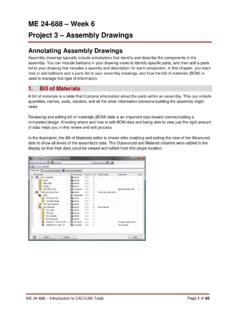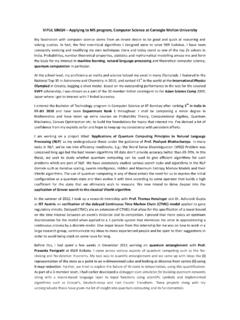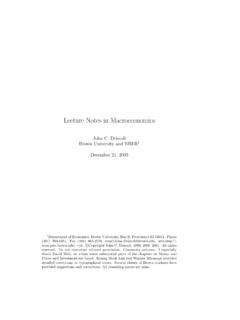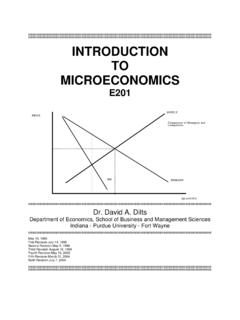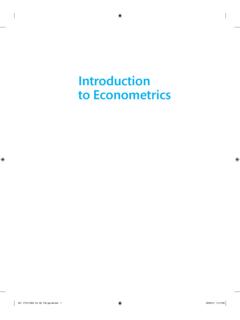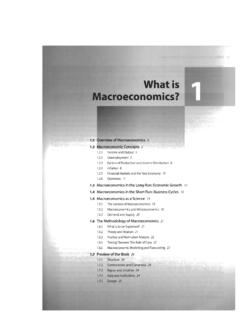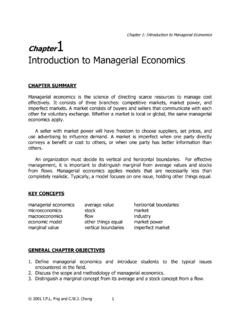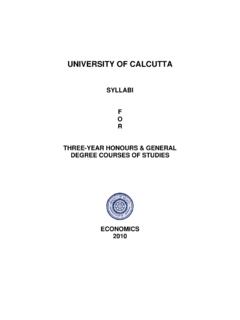Transcription of Macroeconomics
1 MacroeconomicsFifth EditionSTEPHEN D. WILLIAMSONW ashington University in St. LouisEditor in Chief: Donna BattistaCreative Art Director: Jayne ConteAVP/Executive Editor: David AlexanderCover Designer: Suzanne DudaAcquisitions Editor: Christina MasturzoCover Art: ShutterstockSenior Editorial Project Manager: Lindsey SloanMedia Project Manager: Lisa RinaldiEditorial Assistant: Emily BrodeurFull-Service Project Management: Integra SoftwareDirector of Marketing: Maggie MoylanServices Pvt. Marketing Manager: Lori DeshazoPrinter/Binder: Edwards Bros/Malloy-State StreetSenior Marketing Assistant: Kimberly LovatoCover Printer: Lehigh/Phoenix-HagerstownManaging Editor: Jeffrey HolcombText Font: Berkeley-BookCredits and acknowledgments borrowed from other sources and reproduced, with permission, in this textbook appearon the appropriate page within and WindowsR are registered trademarks of the Microsoft Corporation in the and other shots and icons reprinted with permission from the Microsoft Corporation.
2 This book is not sponsored orendorsed by or affiliated with the Microsoft 2014, 2011, 2008 by Pearson Education, All rights reserved. Manufactured in the United States ofAmerica. This publication is protected by Copyright, and permission should be obtained from the publisher prior toany prohibited reproduction, storage in a retrieval system, or transmission in any form or by any means, electronic,mechanical, photocopying, recording, or likewise. To obtain permission(s) to use material from this work, pleasesubmit a written request to Pearson Education, Inc., Permissions Department, One Lake Street, Upper Saddle River,New Jersey 07458, or you may fax your request to of the designations by manufacturers and sellers to distinguish their products are claimed as those designations appear in this book, and the publisher was aware of a trademark claim, the designationshave been printed in initial caps or all of Congress Cataloging-in-Publication DataWilliamson, Stephen / Stephen D.
3 Williamson. 5th : 978-0-13-299133-9 ISBN-10: 0-13-299133-01. Macroeconomics . I. 2014339 : 0-13-299133-0 ISBN-13: 978-0-13-299133-9 CONTENTSPA R T IIntroduction and Measurement Issues 1 chapter 1 introduction 2 What Is Macroeconomics ? 2 Gross Domestic Product, Economic Growth,and Business Cycles 3 Macroeconomic Models 7 Microeconomic Principles 10 Disagreement in Macroeconomics 11 What Do We Learn from Macroeconomic Analysis? 12 Understanding Recent and Current Macroeconomic Events 15 chapter Summary 33 Key Terms 33 Questions for Review 34 Problems 35 Working with the Data 36 chapter 2 Measurement 37 Measuring GDP: The National Income and Product Accounts 37 Nominal and Real GDP and Price Indices 46 Macroeconomics INACTION: Comparing Real GDP AcrossCountries and the Penn Effect 54 Macroeconomics INACTION: House Prices and GDPM easurement 55 Savings, Wealth, and Capital 57 Labor Market Measurement 58 Macroeconomics INACTION.
4 Alternative Measures of theUnemployment Rate 60 chapter Summary 62 Key Terms 62 Questions for Review 64 Problems 64 Working with the Data 67 chapter 3 Business Cycle Measurement 68 Regularities in GDP Fluctuations 68iiiivContentsMACROECONOMICS INACTION: Economic Forecasting and theFinancial Crisis 71 Comovement 72 The Components of GDP 78 Nominal Variables 81 Labor Market Variables 84 Macroeconomics INACTION: Jobless Recoveries 86 Seasonal Adjustment 88 Macroeconomics INACTION: The Great Moderation and the2008 2009 Recession 89 Comovement Summary 91 chapter Summary 92 Key Terms 92 Questions for Review 93 Problems 94 Working with the Data 94PA R T I IA One-Period Model of the Macroeconomy 95 chapter 4 Consumer and Firm Behavior: The Work LeisureDecision and Profit Maximization 96 The Representative Consumer 97 The Representative Firm 116 Macroeconomics INACTION: How Elastic is LaborSupply?
5 117 Macroeconomics INACTION: Henry Ford and Total FactorProductivity 127 THEORYCONFRONTS THEDATA: Total Factor Productivity and Aggregate Production Function 128 chapter Summary 131 Key Terms 132 Questions for Review 133 Problems 134 Working with the Data 136 chapter 5A Closed-Economy One-Period MacroeconomicModel 137 Government 138 Competitive Equilibrium 138 Optimality 145 Working with the Model: The Effects of a Change in GovernmentPurchases 151 THEORYCONFRONTS THEDATA: Government Spending in WorldWar II 153 Working with the Model: A Change in Total FactorProductivity 154 ContentsvTHEORYCONFRONTS THEDATA: Total Factor Productivity, RealGDP, and Energy Prices 159 Macroeconomics INACTION: Government Expenditures and theAmerican Recovery and Reinvestment Act of 2009 162A Distorting Tax on Wage Income, Tax Rate Changes, and the LafferCurve 166A Model of Public Goods: How Large Should the GovernmentBe?
6 173 chapter Summary 177 Key Terms 177 Questions for Review 178 Problems 179 Working with the Data 181 chapter 6 Search and Unemployment 182 Labor Market Facts 183 Macroeconomics INACTION: Unemployment and Employmentin the United States and Europe 187A Diamond-Mortensen-Pissarides Model of Searchand Unemployment 189 Working with the DMP Model 199 Macroeconomics INACTION: Unemployment Insurance andIncentives 201 THEORYCONFRONTS THEDATA: Productivity, Unemployment, andReal GDP in the United States and Canada: The 2008 2009 Recession 207A Keynesian DMP Model 209 Macroeconomics INACTION: The Natural Rate ofUnemployment and the 2008 2009 Recession 213 chapter Summary 214 Key Terms 215 Questions for Review 215 Problems 216 Working with the Data 217 PART IIIE conomic Growth 219 chapter 7 Economic Growth: Malthus and Solow 220 Economic Growth Facts 221 The Malthusian Model of Economic Growth 226 The Solow Model: Exogenous Growth 237 THEORYCONFRONTS THEDATA: The Solow Growth Model,Investment Rates, and Population Growth 250 Macroeconomics INACTION: Resource Misallocation and TotalFactor Productivity 252viContentsMACROECONOMICS INACTION: Recent Trends in EconomicGrowth in the United States 253 Growth Accounting 254 Macroeconomics INACTION.
7 Development Accounting 261 chapter Summary 263 Key Terms 264 Questions for Review 264 Problems 265 Working with the Data 267 chapter 8 Income Disparity Among Countries and EndogenousGrowth 268 Convergence 269 THEORYCONFRONTS THEDATA: Is Income Per Worker Convergingin the World? 274 Macroeconomics INACTION: Measuring Economic Welfare: PerCapita Income, Income Distribution, Leisure,and Longevity 275 Endogenous Growth: A Model of Human CapitalAccumulation 276 Macroeconomics INACTION: Education and Growth 285 chapter Summary 287 Key Terms 287 Questions For Review 287 Problems 288 Working with the Data 289PA R T I VSavings, Investment, and Government Deficits 291 chapter 9A Two-Period Model: The Consumption SavingsDecision and Credit Markets 292A Two-Period Model of the Economy 293 THEORYCONFRONTS THEDATA: Consumption Smoothing and theStock Market 309 The Ricardian Equivalence Theorem 321 Macroeconomics INACTION: The Economic Growth and TaxRelief Reconciliation Act and National Saving 331 THEORYCONFRONTS THEDATA.
8 Government FinancingArithmetic: Are Government Budget Deficits Sustainable? 333 chapter Summary 336 Key Terms 337 Questions for Review 338 Problems 339 Working with the Data 341 chapter 10 Credit Market Imperfections: Credit Frictions,Financial Crises, and Social Security 342 Credit Market Imperfections and Consumption 344 ContentsviiCredit Market Imperfections, Asymmetric Information, and theFinancial Crisis 347 THEORYCONFRONTS THEDATA: Asymmetric Information andInterest Rate Spreads 349 Credit Market Imperfections, Limited Commitment,and the Financial Crisis 351 THEORYCONFRONTS THEDATA: The Housing Market, Collateral,and Consumption 354 THEORYCONFRONTS THEDATA: Low Real Interest Rates and theFinancial Crisis 361 Social Security Programs 363 Macroeconomics INACTION.
9 Transitions from Pay-As-You-Goto Fully Funded Social Security 369 chapter Summary 370 Key Terms 371 Questions for Review 371 Problems 372 Working with the Data 374 chapter 11A Real Intertemporal Model with Investment 375 The Representative Consumer 376 The Representative Firm 382 THEORYCONFRONTS THEDATA: Investment and the Interest RateSpread 394 Government 396 Competitive Equilibrium 397 The Equilibrium Effects of a Temporary Increase inG: Stimulus, theMultiplier, and Crowding Out 408 Macroeconomics INACTION: The Total Government SpendingMultiplier: Barro vs. Romer 412 The Equilibrium Effects of a Decrease in the Current CapitalStockK414 The Equilibrium Effects of an Increase in Current Total FactorProductivityz415 The Equilibrium Effects of an Increase in Future Total FactorProductivity,z : News About the Future and AggregateEconomic Activity 418 THEORYCONFRONTS THEDATA: News, the Stock Market, andInvestment Expenditures 419 Credit Market Frictions and the Financial Crisis 421 THEORYCONFRONTS THEDATA: Interest Rate Spreads andAggregate Economic Activity 423 Sectoral Shocks and Labor Market Mismatch 425viiiContentsTHEORYCONFRONTS THEDATA.
10 The Behavior of Real GDP,Employment, and Labor Productivity in the 1981 1982 and2008 2009 Recessions 428 chapter Summary 431 Key Terms 432 Questions for Review 432 Problems 433 Working with the Data 435PA R T VMoney and Business Cycles 437 chapter 12 Money, Banking, Prices, and Monetary Policy 438 What Is Money? 439A Monetary Intertemporal Model 440A Level Increase in the Money Supply and MonetaryNeutrality 454 Shifts in Money Demand 457 THEORYCONFRONTS THEDATA: Instability in the Money DemandFunction 460 The Short-Run Non-Neutrality of Money: Friedman Lucas MoneySurprise Model 462 The Zero Lower Bound and Quantitative Easing 472 Macroeconomics INACTION: Empirical Evidence onQuantitative Easing 475 chapter Summary 478 Key Terms 479 Questions for Review 480 Problems 481 Working with the Data 482 chapter 13 Business Cycle Models with Flexible Prices andWages 483 The Real Business Cycle Model 485A Keynesian Coordination Failure Model 493 Macroeconomics INACTION: Business Cycle Models and theGreat Depression 494A New Monetarist Model.
